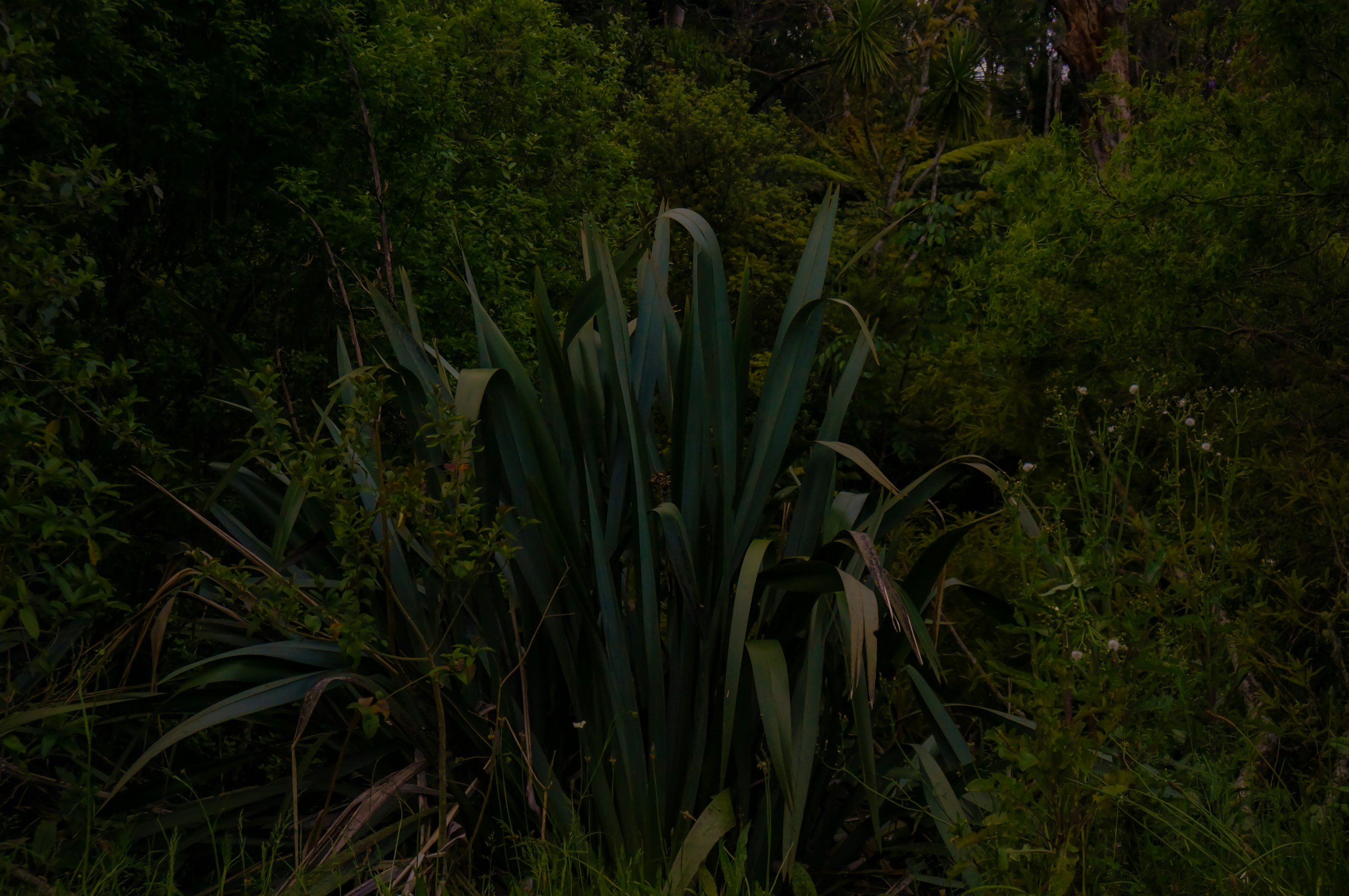
A Flax By Any Other Name…
Harakeke: Its cultural significance and uses
Fun Fact: The term pā harakeke, whilst on the one hand meaning a plantation of harakeke, is also used as a term for children and grandchildren in te reo Māori.
The softer part of the leaf was wrapped around wounds to act as a bandage, with the thicker base of the leaf being used as a splint to support broken bones. The muka was used to stop bleeding and for stitches, as well as for tying umbilical cords. The gum produced by harakeke was applied to burns, wounds, and sores, and used on plasters to enable them to stick to wounds. The roots were ingested as a way of treating disease, colds, and headaches; they could also be applied topically to treat skin conditions and growths. The nectar from the puāwai (flower) of harakeke was used to make a drink, by adding it to water. Harakeke seeds and gum are also edible, with the seeds used to make oil as well as coffee.
‘Of great consequence to us as a naval power’
Despite the varied uses of harakeke by Māori, and the array of material culture that could be made from its leaves and muka, Europeans were focused on making rope and cordage from it. In 1794, running rigging was made for the rig the Fancy from harakeke by Māori weavers at Thames on the North Island, as well as for the ship Matilda in 1813 in Otago Harbour on the South Island.
In 1825, a report was requested of the quality of wheel rope made from harakeke that had been issued to HMS Wellesley.
In 1830, a request was made by Captain of the Royal Navy, George Harris, to use the solution of Cahuchu (natural rubber latex) from harakeke to make cordage. This was then to be trialled in Portsmouth to assess its durability in comparison to other types of rope.
Mechanical processing of harakeke & flax mills in Aotearoa New Zealand
The mechanical stripping of harakeke muka and the way in which European flax fibre are processed, include several similar steps of manually separating parts of the plant, soaking or washing, and pounding, scutching, or combing to soften the fibres.
Scutching is a process where L. usitatissimum is dressed by the removal of the woody stem, or when the short ends of the muka were sorted from the long ends, in the case of harakeke, thus refining the muka.
The processes and plants are different enough, however, that mass production methods appropriate for L. usitatissimum rendered harakeke muka useful only for heavy duty cordage, not the fine linen-like materials Cook and his crew had encountered earlier.
By 1873, there were 300 working mills producing muka from harakeke, with exports of over 6,000 tons. This number had decreased significantly by 1880 when only 40 mills producing harakeke muka were in operation. Muka was primarily being produced on an industrial scale to make rope, wool packs, and carpets.
At the beginning of the twentieth century the diseases ‘Yellow leaf’ killed large amounts of harakeke. At the same time, a shortage of the plant sisal during the Spanish-American War increased the demand for harakeke muka, leading to a compulsory grading of the quality of muka in 1902. By 1905 the number of mills in operation had increased once more to 240.
The chemical and mechanical processing of harakeke muka in the British Isles
Seven years later there was a provisional registration of The New Zealand Flax Company by one William Edwards, ‘Gentleman’, of London, with the purpose of:
‘collect[ing] and import[ing] the Phormium Tenax or New Zealand Flax and by the application of certain mechanical and chemical processes to bring it to a state fit for manufacturing purposes’.
Later, in 1864, The New Zealand Flax Company was registered with a head office located in Westminster, London, with 400 shares in the company by the following year. The aim of the company was ‘the working of patents for preparing the ‘Formium [sic] Tenax’ or New Zealand Flax, and other fibrous materials’ as well as to put in place the necessary machinery and buildings in order to process harakeke muka’. The company, however, was dissolved in 1882.
References
-
Vennell, R. (2019). The Meaning of Trees: The history and use of New Zealand’s native plants. Auckland, New Zealand: HarperCollins Publishers New Zealand Limited, p.197.
Te māra reo the language garden (nd). Whara, Whararahi, Wharariki, Harakeke [Online]. Te Māra Reo. Available at: https://www.temarareo.org/TMR-Whara.html [Accessed 25 November 2024].
University of Hawai’I at Mānoa Library (nd). Traditional Pacific Island Crops: Pandanus [Online] Traditional Pacific Island Crops. Last Updated: 20 July 2022. Available at: https://guides.library.manoa.hawaii.edu/paccrops/pandanus [Accessed 25 November 2024].
Te Ahukaramū Charles Royal (2007). Harakeke plant [Online] Story: Te Waonui a Tāne – forest mythology - Symbolism of trees and plants. Available at: http://www.TeAra.govt.nz/en/diagram/13162/harakeke-plant [accessed 25 November 2024].
Grace, W. (nd). How Māui slowed the sun [Online] Mātauranga Māori. Available at: https://eng.mataurangamaori.tki.org.nz/Support-materials/Te-Reo-Maori/Maori-Myths-Legends-and-Contemporary-Stories/How-Maui-slowed-the-sun [Accessed 25 November 2024].
Vennell, The Meaning of Trees, p. 195.
White, T (2022). Wānangatia Te Wahakura: Weaving Wellbeing for Mokopuna and Whānau
Republished from Embodied Knowledge, Issue 3 of The Vessel [Online]. Objectspace. Available at: https://www.objectspace.org.nz/journal/wanangatia-te-wahakura-weaving-wellbeing/ [accessed 25 November 2024].
Museum of New Zealand Te Papa Tongarewa (nd). Kaitaka style of cloak [Online]. Te Papa Collections. Available at: https://collections.tepapa.govt.nz/topic/3632 [Accessed 25 November 2024].
Te Aka (nd). Pā harakeke [Online]. Te Aka Māori Dictionary. Available at: https://maoridictionary.co.nz/word/48339 [Accessed 25 November 2024].
Vennell, The Meaning of Trees, pp. 197-199.
Cordery, H (nd). 5 Native Plants Used In Māori Medicine [Online]. Pūkaha National Wildlife Centre. Available at: https://pukaha.org.nz/5-native-plants-used-in-maori-medicine/ [Accessed 25 November 2024].
-
Cook, J. (1977). The journal of H.M.S. Endeavour, 1768-1771. Guildford (45 Stoke Rd, Guildford, Surrey GU1 4HT): Genesis Publications Limited [etc.]. British Library MS FACS 865, p. 212.
Shepherd, L. D., Scheele, S. M., Te Awa, I., Smissen, R. D. (2023). ddRADseq reveals the relationships of harakeke and wharariki (Phormium species, Asphodelaceae) and selected weaving cultivars in Aotearoa New Zealand. Botanical Journal of the Linnean Society, 201(2), 198–214. Available at: https://doi.org/10.1093/botlinnean/boac043 [Accessed 25 November 2024].
Shepherd, L.D. (2023). A history of harakeke flax on Norfolk Island. [Online]. Te Papa Blog. Last modified: 23 May 2023. Available at: https://blog.tepapa.govt.nz/2023/05/23/a-history-of-harakeke-flax-on-norfolk-island/ [Accessed 25 November 2024].
Parkinson, S. (1773). Chiefs, warriors and war canoes &c. (continued). [Online]. Paul Turnbull. Available at: https://paulturnbull.org/project/southseas/journals/parkinson/134.html [Accessed 25 November 2024].
Scheele, S (nd). Harakeke and Wharariki Phormium tenax and Phormium cookianum. [Online]. Manaaki Whenua – Landcare Research. Available at: https://www.landcareresearch.co.nz/tools-and-resources/collections/new-zealand-flax-collections/weaving-plants/harakeke-and-wharariki/ [Accessed 25 November 2024].
Department of Conservation Te Papa Atawhai (nd). Harakeke/flax [Online]. Department of Conservation Te Papa Atawhai. Available at: https://www.doc.govt.nz/nature/native-plants/harakeke-flax/ [Accessed 25 November 2024].
Skelton, C. (2015). Linseed: Flax And Its Other Names. [Online]. Flax Farm. Available at: https://www.flaxfarm.co.uk/biblical/linseed-flax-and-other-names-1/ [Accessed 25 November 2024].
Eckel, P. M. (2023). A Grammatical Dictionary of Botanical Latin. [Online]. Mobot. Available at: https://www.mobot.org/mobot/latindict/keyDetail.aspx?keyWord=linum [Accessed 25 November 2024].
Bhajantri, V., Shakunthala, N.M., Singh, P.K., Vasudevan, S.N., Macha, S. I., Kisan, B., Patel, S. (2017). DUS characterization of linseed (Linum usitatissimum L.) germplasm. Agriculture Update, 12 (TECHSEAR-5): 1275-1280. Available at: DOI: 10.15740/HAS/AU/12.TECHSEAR(5)2017/.
Cotswold Seeds (nd). Linseed Other (Linum usitatissimum). [Online]. Cotswold Seeds. Available at: https://www.cotswoldseeds.com/species/104/linseed [Accessed 25 November 2024].
Wesco Seeds Limited (nd). Linseed. [Online]. Wesco Seeds Limited. Available at: https://wesco.co.nz/product/cereals/linseed/ [Accessed 25 November 2024].
Tates of Sussex (nd). Flax 'Scarlet Linum' Seeds. [Online]. Tates of Sussex Garden Centres. Available at: https://www.tatesofsussex.co.uk/shop/products/garden-plants/bulbs-seeds/garden-seeds/ornamentals/flax-scarlet-linum.html [Accessed 25 November 2024].
Gardenia (nd). Linum usitatissimum (Common Flax). [Online]. Gardenia. Available at: https://www.gardenia.net/plant/linum-lusitatissimum [Accessed 25 November 2024].
Forster, J. R., Forster, G. (1776). Characteres generum plantarum: quas in itinere ad insulas maris Australis, collegerunt, descripserunt, delinearunt, annis mdcclxxii-mdcclxxv. Londini (London): B. White, T. Cadell, & P. Elmsly., p. 48. [Online]. Available at: https://archive.org/details/mobot31753002810437/ [Accessed 25 November 2024].
Vennell, The Meaning of Trees, p. 195.
Raoul, É. (1846). Choix de plantes de la Nouvelle-Zélande recueillies et décrites par M. E. Raoul chirurgien de première classe de la marine royale. Paris: Fortin, Masson et Cie., p. 41. [Online]. Available at: https://gallica.bnf.fr/ark:/12148/bpt6k1025092h/f9 [Accessed 25 November 2024].
Hooker, W. J. (1848). The London journal of botany; containing figures and descriptions of such plants as recommend themselves by their novelty, rarity, history, or uses; together with botanical notices and information, and occasional portraits and memoirs of eminent botanists...Vol. VII. With twenty- three plates. London: Reeve, Benham, and Reeve., p. 536. [Online]. Available at: https://www.biodiversitylibrary.org/page/777600 [Accessed 25 November 2024].
-
Stapley, K. (2024). A settlement in the Pacific Ocean for growing flax. [Online]. Untold lives blog, British Library. Available at: https://blogs.bl.uk/untoldlives/2024/04/a-settlement-in-the-pacific-ocean-for-growing-flax.html [Accessed 25 November].
University of Otago Library (nd). General Items - Reproduced Map of New Zealand originally drawn in chalk on the floor by two Maori Chiefs, Tuki Tahua and Ngahuruhuru, at Norfolk Island, 1793. [Online]. He Tirohanga Ki Muri A View Of The Past. Available at: https://www.otago.ac.nz/library/exhibitions/he_tirohanga_ki_muri/general_items.html [Accessed 25 November 2024].
Sheperd, L. (2023). A history of harakeke flax on Norfolk Island [Online]. Te Papa Blog. Available at: https://blog.tepapa.govt.nz/2023/05/23/a-history-of-harakeke-flax-on-norfolk-island/ [Accessed 25 November 2024].
Goulding, J. H. (2009). History of the Phormium Fibre Export Trade - FLAX. [Online]. Te Ara. Available at: https://teara.govt.nz/en/1966/27676/print [Accessed 25 November 2024].
Tucker, J., Thomson, J., Boyle, C. (1825). Navy Board order to Captain Hammond of the WELLESLEY to test and report on New Zealand flax wheel rope supplied to the ship. [Manuscript Documents]. ADL/D/16. National Maritime Museum, Greenwich, London.
Board of Admiralty (1830). Captain George Harris asked to be allowed to proceed in making cordage manufactured with the solution of Cahuchu from the Phormium Tenax. We do not feel justified in doing so until we receive your further directions. [Public records]. ADM/BP/50C/59-5, National Maritime Museum, Greenwich, London.
-
Goulding, History of the Phormium Fibre Export Trade – FLAX.
Swarbrick, N. (2007). Flax and flax working [Online]. Te Ara - the Encyclopedia of New Zealand. Available at: http://www.TeAra.govt.nz/en/flax-and-flax-working/print [Accessed 25 November 2024].
-
Burns, J. (1840). Burns Specimens of New Zealand Flax. ‘Ireland: Home Office correspondence: miscellaneous subjects’, HO 100/263/317. The National Archives, London.
Imperial Institute (1942). Phormium tenax: cultivation in the Isle of Man, AY4/461. The National Archives, London.
Imperial Institute (1935-1937). Phormium tenax grown in Devon, AY4/509. The National Archives, London.
New Zealand Flax Company (1844-c1860). New Zealand Flax Company. Registered between 1844 and 1856, and either dissolved before 1856 or re-registered by 1860, BT 41/497/2742, f. 2r. The National Archives, London.
New Zealand Flax Company Limited (1864-[1916]). Company No: 1351 C; New Zealand Flax Company Limited. Incorporated in 1864. Dissolved before 1916, BT 31/964/1351C, The National Archives, London.

